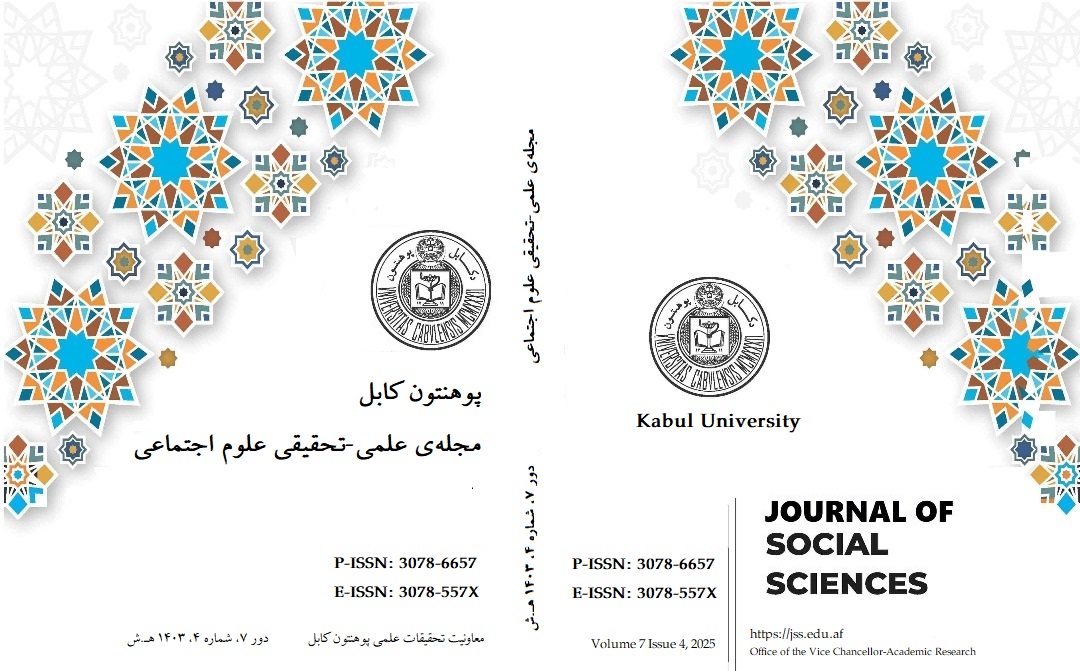Main Article Content
Abstract
The Ghaznavids are considered one of the most influential royal dynasties in the Islamic world and Afghanistan, who came to power in Ghazni, a strategic city in Khorasan (present-day Afghanistan), in the late fourth century AH (tenth century AD). The rise of the Ghaznavids was not only the product of military prowess, but also the result of complex political, economic, cultural, and social interactions in the region. The study of how the Ghaznavid state was established in Afghanistan has had outstanding historical, political, economic, cultural, and social significance. The main objective of this research is to analyze the political, social, and military factors that led to the formation of the Ghaznavid state in the 10th century AD. By studying reliable historical sources, the study research methods have been used in the preparation and arrangement of this article. The importance of this research lies in better understanding the political and cultural developments in Afghanistan during the Ghaznavid era, which laid the foundation for major developments in the history of the region. The research findings show that the Ghaznavids, using their geographical location and military power, were able to establish an independent monarchy and establish extensive relations with neighboring empires. The results of this research can be useful in further understanding the process of formation of Islamic states in Asia and its impact on the history of Afghanistan.
Keywords
Article Details
Copyright (c) 2025 Journal of Social Sciences - Kabul University

This work is licensed under a Creative Commons Attribution-NonCommercial 4.0 International License.
References
- آلسیو، ا و اتینگهازون، ر. (1394). هنر سامانی و غزنوی. چاپ چهارم، ترجمه یعقوب آژند، تهران: انتشارات مولی.
- ابن اثیر، ا. (1386). تاریخالکامل، ترجمه محمد حسین روحانی، تهران: انتشارات امیر کبیر.
- بارتولد، و. (1366). ترکستان نامه. ترجمه کریم کشاورز، جلد دوم، تهران: انتشارات آگاه.
- باسورث، ا. (1381). تاریخ غزنویان. ترجمهحسن انوشه، جلداول و دوم، چاپ سوم، تهران: انتشارات امیرکبیر.
- بلاذری، ا. (1367). فتوح البلدان. ترجمه م توکل، چاپ اول، تهران: نشر نقره.
- بیهقی، ا. (1319). تاریخ بیهقی. چاپ سوم،تهران: انتشارات طبع کتاب.
- پیگولوسکایا، ن. (1363). تاریخ ایران از عهد باستان تا پایان ّسده هژده هم. ترجمه کریم کشاورز، چاپ پنجم، تهران: نشر پیام.
- توران، ع . (1389). نگاهی به تاریخ فرهنگ ترکمنها. چاپ اول، کابل: شرکت خدماتی دانی.
- جعفریان، ر. (1381). از طلوع طاهریان تا غروب خوارزمشاهیان. جلد دوم، چاپ سوم، تهران: موسسه فرهنگی دانش و اندیشه.
- جوزجانی، م. (1333). طبقات ناصری. جلداول، چاپ دوم، کابل: مطبعه دولتی.
- حبیبی، ع . (۱۳۴۴). تاریخ مختصرافغانستان. چاپ،سوم، پشاور: دانش کتابخانه.
- حسن، ا. (1385). تاریخ سیاسی اسلام. ترجمه ابوالقاسم پاینده،جلد چهارم،چاپ دوم،تهران: نشر جاویدان.
- خلیلی، خ. (1390). سلطنت غزنویان. چاپ سوم،کابل: انتشارات امیری.
- زرینکوب، ع. (1379). روزگاران تاریخ ایران. چاپ دوم، تهران، انتشارات سخن.
- ستارزاده، م. (1386). سلجوقیان. چاپ سوم، همدان: کتابخانه ملی ایران.
- سرهنگ، پ. (1365). تاریخ افغانستان از فتوحات اعراب تا سلجوقیان. چاپ اول، کابل: انتشارات فرهنگ.
- صفا، ذ. (1385). تاریخ ادبیات فارسی. جلد دوم، چاپ هفدهم، تهران: انتشارات فردوسی.
- عتبی، م. (1387). تاریخ یمینی. تهران: مرکز تحقیقی میراث مکتوب.
- غبار، م. (1366). افغانستان در مسیر تاریخ. جلد اول و دوم، چاپ اول، کابل: مطبعه دولتی.
- فروزانی، ا. (1386). غزنویان از پیدایش تا فروپاشی. چاپ دوم، تهران: انتشارات سمت.
- کمال، م. (1377). افغانسنتان سرزمین آریا. جلد اول، چاپ اول، کابل: مطبعه دولتی.
- گردیزی، ا. (1363). زین الاخبار. چاپ اول، تهران: دنیای کتاب.
- میرخواند، م. (1339). تاریخ روضِة الصفا. جلدچهارم، تهران: چاپ پیروز.
- مستوفی، ح. (1328). تاریخ گزیده. جلد اول، چاپ سوم، تهران: انتشارات امیر کبیر.
- مسعودی، ا. (1374). مروج الذهب و معادن الجوهر. ابوالقاسم پاینده، تهران: انتشارات فردوسی.
References
آلسیو، ا و اتینگهازون، ر. (1394). هنر سامانی و غزنوی. چاپ چهارم، ترجمه یعقوب آژند، تهران: انتشارات مولی.
ابن اثیر، ا. (1386). تاریخالکامل، ترجمه محمد حسین روحانی، تهران: انتشارات امیر کبیر.
بارتولد، و. (1366). ترکستان نامه. ترجمه کریم کشاورز، جلد دوم، تهران: انتشارات آگاه.
باسورث، ا. (1381). تاریخ غزنویان. ترجمهحسن انوشه، جلداول و دوم، چاپ سوم، تهران: انتشارات امیرکبیر.
بلاذری، ا. (1367). فتوح البلدان. ترجمه م توکل، چاپ اول، تهران: نشر نقره.
بیهقی، ا. (1319). تاریخ بیهقی. چاپ سوم،تهران: انتشارات طبع کتاب.
پیگولوسکایا، ن. (1363). تاریخ ایران از عهد باستان تا پایان ّسده هژده هم. ترجمه کریم کشاورز، چاپ پنجم، تهران: نشر پیام.
توران، ع . (1389). نگاهی به تاریخ فرهنگ ترکمنها. چاپ اول، کابل: شرکت خدماتی دانی.
جعفریان، ر. (1381). از طلوع طاهریان تا غروب خوارزمشاهیان. جلد دوم، چاپ سوم، تهران: موسسه فرهنگی دانش و اندیشه.
جوزجانی، م. (1333). طبقات ناصری. جلداول، چاپ دوم، کابل: مطبعه دولتی.
حبیبی، ع . (۱۳۴۴). تاریخ مختصرافغانستان. چاپ،سوم، پشاور: دانش کتابخانه.
حسن، ا. (1385). تاریخ سیاسی اسلام. ترجمه ابوالقاسم پاینده،جلد چهارم،چاپ دوم،تهران: نشر جاویدان.
خلیلی، خ. (1390). سلطنت غزنویان. چاپ سوم،کابل: انتشارات امیری.
زرینکوب، ع. (1379). روزگاران تاریخ ایران. چاپ دوم، تهران، انتشارات سخن.
ستارزاده، م. (1386). سلجوقیان. چاپ سوم، همدان: کتابخانه ملی ایران.
سرهنگ، پ. (1365). تاریخ افغانستان از فتوحات اعراب تا سلجوقیان. چاپ اول، کابل: انتشارات فرهنگ.
صفا، ذ. (1385). تاریخ ادبیات فارسی. جلد دوم، چاپ هفدهم، تهران: انتشارات فردوسی.
عتبی، م. (1387). تاریخ یمینی. تهران: مرکز تحقیقی میراث مکتوب.
غبار، م. (1366). افغانستان در مسیر تاریخ. جلد اول و دوم، چاپ اول، کابل: مطبعه دولتی.
فروزانی، ا. (1386). غزنویان از پیدایش تا فروپاشی. چاپ دوم، تهران: انتشارات سمت.
کمال، م. (1377). افغانسنتان سرزمین آریا. جلد اول، چاپ اول، کابل: مطبعه دولتی.
گردیزی، ا. (1363). زین الاخبار. چاپ اول، تهران: دنیای کتاب.
میرخواند، م. (1339). تاریخ روضِة الصفا. جلدچهارم، تهران: چاپ پیروز.
مستوفی، ح. (1328). تاریخ گزیده. جلد اول، چاپ سوم، تهران: انتشارات امیر کبیر.
مسعودی، ا. (1374). مروج الذهب و معادن الجوهر. ابوالقاسم پاینده، تهران: انتشارات فردوسی.
